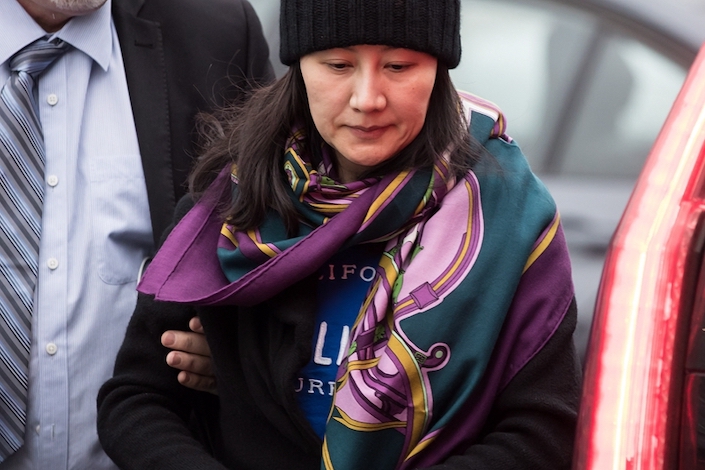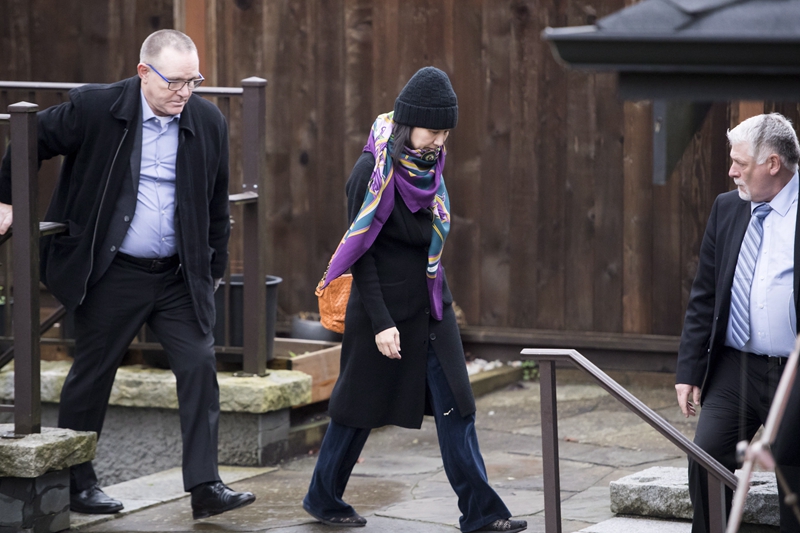In-Depth: The Shockwaves of Meng Wanzhou’s Arrest

* The arrest of Meng is another setback for China’s telecom technology bellwether Huawei, which faces increasing hurdles to introduce its next-generation 5G wireless technologies around the world
* Rising hurdles abroad, especially pressures from the U.S., have clouded Huawei’s outlook
For Meng Wanzhou, the “only simple goal” being released from jail in Canada last week was to be with her family. But outside the walls of her residence on Vancouver’s west side, a global storm over her arrest still rages.
The 46-year-old Chinese businesswoman is the chief financial officer and deputy chairwoman of Chinese telecom giant Huawei Technologies, an increasingly controversial company in the U.S. She was detained Dec. 1 while changing planes in Canada on the request of U.S. authorities seeking her extradition to face fraud charges related to violations of sanctions on Iran.
After a three-day court hearing in Vancouver, Meng was released on Can$10 million ($7.46 million) bail Dec. 11 with strict supervision conditions including around-the-clock surveillance and an electronic ankle bracelet. Meng’s lawyer told the court on the final day of the bail hearing that what his client wants is a peaceful time to read books after 25 years of hard work.
Meng’s father, Ren Zhengfei, created Huawei in 1987. She is widely recognized as the heiress-apparent of the world’s second-largest smartphone maker behind South Korea’s Samsung. In 2017, Huawei reported global revenue of nearly $90 billion with net profit of $7 billion. Ren, with a net worth of $3.2 billion, is the world's 83rd-richest person, according to documents revealed in court.
The case drew global attention not only because of the significance of the individuals involved but also because of intricate international implications.
The arrest of Meng occurred on the same day that Chinese President Xi Jinping and U.S. President Donald Trump agreed during a meeting in Argentina on a truce to the months-long trade war between the two countries. A key contention that triggered the trade war is China’s strategy for advancing its technology industry, in which Huawei plays a leading role.
The high-profile arrest fueled fears that it may jeopardize the fragile truce, although senior officials of the Trump administration have downplayed the arrest and distanced the president from the matter. U.S. Trade Representative Robert Lighthizer said Dec. 9 that the arrest “is a criminal justice matter” and “totally separate from” the China-U.S. trade talks.
Shortly after Meng’s release, Trump said in an interview with Reuters that he would intervene in the case with the U.S. Justice Department if it would help secure a trade deal with China.
The Chinese government reacted strongly to Meng’s arrest. Vice Foreign Minister Le Yucheng last weekend summoned the U.S. and Canadian ambassadors in protest over the detention, describing it as “unreasonable” and "lawless."
The incident has also put a chill on China-Canadian relations. Earlier this week, two Canadians were reportedly detained in China on allegations of violating national security.
Meng’s release on bail marks just the start of a lengthy legal process that may lead her to stand trial in the U.S. The firestorm of business, legal and political interest sparked by her case continues.
What’s next?
Meng was arrested after she landed the Vancouver International Airport around noon Dec. 1 en route from Hong Kong to Mexico. The previous day, the U.S. government issued a provisional arrest warrant to seek her detention in Canada under Canada’s Extradition Act, court documents showed.
To obtain Meng’s extradition, the U.S. will have to provide enough evidence to persuade a Canadian court that the case is solid enough for Meng to be charged with similar offences in Canada. If the judge rules for extradition, the case will be passed to the Minister of Justice to decide whether to sign an extradition order. Meng will have the opportunity to appeal.
But first, the U.S. government will need to file a formal extradition request within 60 days after Meng’s arrest. If it fails to do so, Meng must be released, according to British Columbia Supreme Court Justice William Ehrcke, who ruled on Meng’s bail.
The U.S. alleged that Meng, in her capacity as CFO, hid a link between Huawei and a Hong Kong company called SkyCom Tech Co., misleading banks in the U.S. into business dealings that violated U.S. sanctions against Iran.
Meng’s lawyer said at the bail hearing that SkyCom became an independent contractor of Huawei after 2008, although the telecom giant was a shareholder of SkyCom from 2002-2008, when Meng was a member of Skycom’s board.
 |
Huawei Chief Financial Officer Meng Wanzhou (center) leaves her home with security guards in Vancouver the day after she was released on Can$10 million bail. Photo: Canada Press |
Meng is “charged with conspiracy to defraud multiple international institutions,” with each charge carrying a maximum sentence of 30 years in prison, Canadian government attorney John Gibb-Carsley, representing the U.S., told the court.
Some legal experts said they believe the U.S. is committed to seeking Meng’s extradition and has enough evidence in hand.
“They are just finishing the paperwork,” said Robert Currie, a law professor at Dalhousie University in Nova Scotia.
But British Columbia-based lawyer Gary Botting, a leading Canadian authority on extradition law, said the absence of a formal extradition request reflects a lack of confidence by the U.S. in the case against Meng. Botting described the evidence provided by prosecutors at Meng’s bail hearing as “the skimpiest.”
Regardless, extradition will be a lengthy procedure taking months or even years, legal experts said.
According to data from Canada’s Department of Justice, 90% of individuals arrested for extradition in the past decade in Canada were eventually surrendered to the countries seeking them, Canada’s CBC News network reported.
Canada’s extradition regime is heavily tilted toward surrendering the targets, Currie said in an article in The Globe and Mail. It takes extraordinary factors to block a request, he wrote.
“But this is, indeed, an extraordinary situation,” Currie wrote.
Huawei’s war
The arrest of Meng is another setback for China’s telecom technology bellwether Huawei, which faces increasing hurdles to introduce its next-generation 5G wireless technologies around the world.
The 5G technology is expected to be a key factor powering the next industrial revolution, bringing profound changes to the economy. Countries and tech companies are competing fiercely to seize an advantage in the new technology, which is expected to debut as soon as next year.
Public records show that Huawei started 5G research in 2009 with a team of 60,000 people. In 2013, the company pledged to invest $600 million in the new technology over five years to compete with global giants Ericsson and Nokia Corp. and domestic rival ZTE Corp. For the first nine months this year, Huawei's global telecom revenue equaled the combined revenue of Nokia and Ericsson, according to the market research organization Dell'Oro.
In November, Huawei said it won 22 contracts for commercial use of its 5G network globally and set up partnerships with 50 telecom carriers to run the new services in South Korea, Great Britain, Italy and Germany.
But Huawei’s 5G ambition also faces increasing setbacks. Several countries including Australia, New Zealand and Japan have shied away from Huawei's technology, citing security concerns.
In an interview with CNBC, Huawei’s rotating Chairman Xu Zhijun said security concerns over Huawei’s 5G technology are based on politics rather than facts.
Huawei and its smaller rival ZTE have seen shrinking access to the U.S. market since 2012, when U.S. lawmakers began to block American wireless carriers from buying equipment from the Chinese companies citing national security threats.
The U.S. government banned ZTE earlier this year from doing business with American suppliers, citing violations of U.S. sanctions on Iran. The ban deprived ZTE's supplies of key components and forced the company to halt major business operations for nearly three months until the ban was lifted. ZTE reported losses of more than 10 billion yuan because of the ban.
Although overseas markets contributed nearly half of Huawei’s $89 billion of revenue in 2017, sales were negligible in the U.S., the world’s second-largest telecom market behind China.
In January at the International Consumer Electronics Show in Las Vegas, Huawei was set to announce a partnership with AT&T to sell mobile phones in the U.S., but Huawei canceled the event without giving a reason. Huawei consumer business chief Richard Yu called it “a loss” for Huawei, the American carrier and U.S. consumers.
Huawei’s business has maintained robust backed by growth elsewhere. By the end of September, Huawei’s share of the global telecom equipment market rose to 28%, up 4 percentage points from 2015, according to Dell’Oro. Founder Ren has set a goal for the company to post annual revenue of $150 billion by 2020, a 50% increase from 2017. But rising hurdles abroad, especially pressures from the U.S., have clouded Huawei’s outlook. In 2017, growth of Huawei’s business with telecom carriers, its main revenue source, plunged to 2.5% from more than 20% in each of the previous two years.
Since 2011, Huawei has moved to diversify its business to corporate networking, mobile devices, and the emerging cloud computing and artificial intelligence chip sectors.
But the sour relationship with the U.S. is still a sword of Damocles hanging over Huawei. It is “almost impossible” for any company to stay away from the U.S. supply chain as it controls most of the global semiconductor industry, a Huawei executive said.
Contact reporter Han Wei (weihan@caixin.com)

- 1Cover Story: Chinese Medicine Injections Face Rigorous Regulation for the First Time
- 2China Sets 2026 Economic Priorities With Demand Revival at the Core
- 3Robotaxi Crash in Hunan Stokes Fears of Regulatory Backlash
- 4China Signals Continued Expansionary Policy for 2026
- 5U.S. to Allow Nvidia H200 Chip Exports to China With 25% Cut
- 1Power To The People: Pintec Serves A Booming Consumer Class
- 2Largest hotel group in Europe accepts UnionPay
- 3UnionPay mobile QuickPass debuts in Hong Kong
- 4UnionPay International launches premium catering privilege U Dining Collection
- 5UnionPay International’s U Plan has covered over 1600 stores overseas






